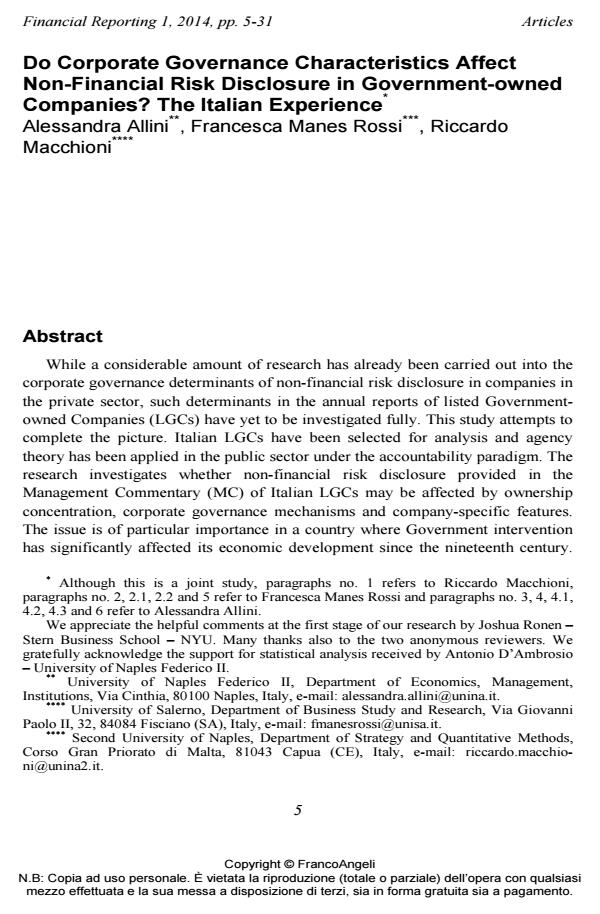Do Corporate Governance Characteristics Affect Non-Financial Risk Disclosure in Government-owned Companies? The Italian Experience
Titolo Rivista FINANCIAL REPORTING
Autori/Curatori Alessandra Allini, Francesca Manes Rossi, Riccardo Macchioni
Anno di pubblicazione 2014 Fascicolo 2014/1
Lingua Inglese Numero pagine 27 P. 5-31 Dimensione file 276 KB
DOI 10.3280/FR2014-001001
Il DOI è il codice a barre della proprietà intellettuale: per saperne di più
clicca qui
Qui sotto puoi vedere in anteprima la prima pagina di questo articolo.
Se questo articolo ti interessa, lo puoi acquistare (e scaricare in formato pdf) seguendo le facili indicazioni per acquistare il download credit. Acquista Download Credits per scaricare questo Articolo in formato PDF

FrancoAngeli è membro della Publishers International Linking Association, Inc (PILA)associazione indipendente e non profit per facilitare (attraverso i servizi tecnologici implementati da CrossRef.org) l’accesso degli studiosi ai contenuti digitali nelle pubblicazioni professionali e scientifiche
While a considerable amount of research has already been carried out into the corporate governance determinants of non-financial risk disclosure in companies in the private sector, such determinants in the annual reports of listed Governmentowned Companies (LGCs) have yet to be investigated fully. This study attempts to complete the picture. Italian LGCs have been selected for analysis and agency theory has been applied in the public sector under the accountability paradigm. The research investigates whether non-financial risk disclosure provided in the Management Commentary (MC) of Italian LGCs may be affected by ownership concentration, corporate governance mechanisms and company-specific features. The issue is of particular importance in a country where Government intervention has significantly affected its economic development since the nineteenth century. Our findings show that there is a relationship between the level of non-financial risk disclosure and Board diversity, leverage and sector. Our findings also reveal some useful insights concerning policy makers and standard setters.
Parole chiave:Government-owned companies; accountability; non-financial risk disclosure; corporate governance. First submission: 26 July 2012, accepted: 20 November 2013.
- Corporate governance and risk disclosure: evidence from Saudi Arabia Abdullah Al-Maghzom, Khaled Hussainey, Doaa Aly, in Corporate Ownership and Control /2016 pp.145
DOI: 10.22495/cocv13i2p14 - Managing cyber risk in the financial sector: Insights from a case study Chiara Crovini, Pier Luigi Marchini, in FINANCIAL REPORTING 1/2023 pp.97
DOI: 10.3280/FR2023-001004 - Non-financial disclosure and women on board: Is a mandatory approach on gender quotas effective to increase communication quality? Rebecca Miccini, in FINANCIAL REPORTING 2/2021 pp.45
DOI: 10.3280/FR2021-002002 - La disclosure nei Piani della Performance delle università italiane. Intenti simbolici verso approcci sostanziali di legittimazione Alessandra Allini, Adele Caldarelli, Rosanna Spanò, in MANAGEMENT CONTROL 1/2017 pp.37
DOI: 10.3280/MACO2017-001003 - Is risk reporting a possible link between financial and management accounting in private firms? Chiara Crovini, Giovanni Ossola, in FINANCIAL REPORTING 1/2021 pp.29
DOI: 10.3280/FR2021-001002 - Compliance with Corporate Governance Principles by Energy Companies Compared with All Companies Listed on the Warsaw Stock Exchange Elżbieta Izabela Szczepankiewicz, Joanna Błażyńska, Beata Zaleska, Farid Ullah, Windham Eugene Loopesko, in Energies /2022 pp.6481
DOI: 10.3390/en15176481 - The Explanatory Factors of Risk Disclosure in the Integrated Reports of Listed Entities in Brazil Fabio Albuquerque, Eveline Monteiro, Maria Albertina Barreiro Rodrigues, in Risks /2023 pp.108
DOI: 10.3390/risks11060108 - Legitimating efforts in Performance Plans. Evidences on the thoroughness of disclosure in the Italian Higher Education setting Alessandra Allini, Adele Caldarelli, Rosanna Spanò, Annamaria Zampella, in MANAGEMENT CONTROL 1/2019 pp.143
DOI: 10.3280/MACO2019-001007 - Audit Committees and COVID-19-Related Disclosure Tone: Evidence from Oman Badar Alshabibi, Shanmuga Pria, Khaled Hussainey, in Journal of Risk and Financial Management /2021 pp.609
DOI: 10.3390/jrfm14120609 - Not Just a Gender Numbers Game: How Board Gender Diversity Affects Corporate Risk Disclosure Andreas Seebeck, Julia Vetter, in Journal of Business Ethics /2022 pp.395
DOI: 10.1007/s10551-020-04690-3 - Board diversity and enterprise risk management: Study in emerging and developed countries Abdul Ghofar, in Corporate Governance and Organizational Behavior Review /2024 pp.180
DOI: 10.22495/cgobrv8i1p15 - Board gender diversity and cyber security disclosure in the Indonesian banking industry: a two-tier governance context Pipin Kurnia, Ardianto Ardianto, in Corporate Governance: The International Journal of Business in Society /2024 pp.1614
DOI: 10.1108/CG-01-2023-0010 - The board's role in risk disclosure: an exploratory study of Italian listed state-owned enterprises Alessandra Allini, Francesca Manes Rossi, Khaled Hussainey, in Public Money & Management /2016 pp.113
DOI: 10.1080/09540962.2016.1118935 - Understanding risk disclosures as a function of social organisation: A neo-Durkheimian institutional theory-based study of Burmah Oil Company 1971–1976 Neveen Abdelrehim, Philip Linsley, Shraddha Verma, in The British Accounting Review /2017 pp.103
DOI: 10.1016/j.bar.2016.10.007
Alessandra Allini, Francesca Manes Rossi, Riccardo Macchioni, Do Corporate Governance Characteristics Affect Non-Financial Risk Disclosure in Government-owned Companies? The Italian Experience in "FINANCIAL REPORTING" 1/2014, pp 5-31, DOI: 10.3280/FR2014-001001